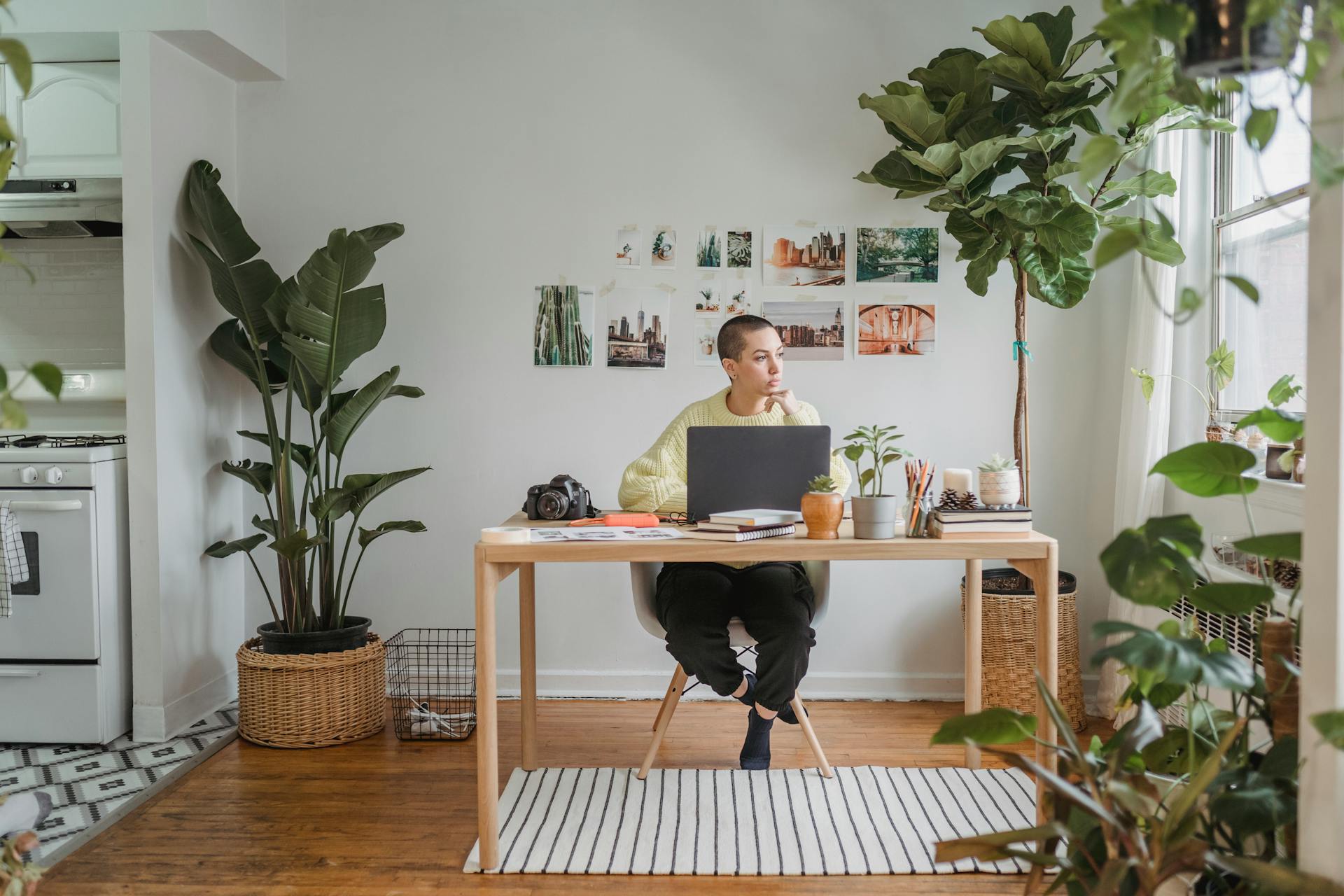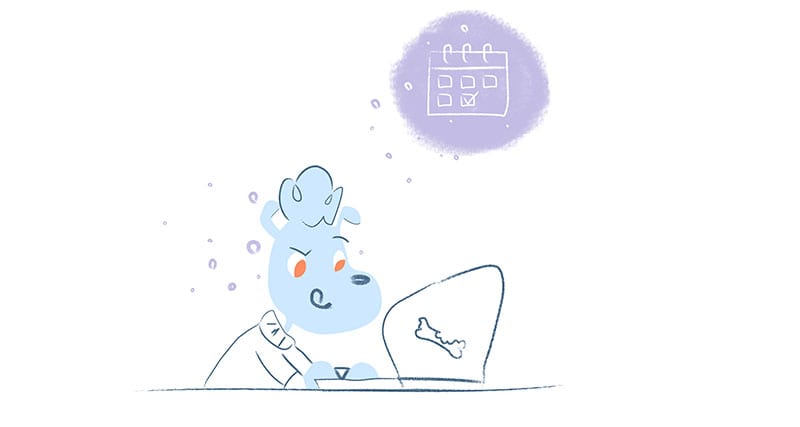

I went to a party last Saturday and ran into some friends I hadn’t seen for years. It was interesting, however, to see how many of us shared the joys of working remotely. At first, I was concerned that so many of us have this luxury. Then again, remote work is becoming increasingly common worldwide. In fact, Pew Research Center estimates that 14% of employed adults working in the U.S. work from home all the time, or about 22 million workers.
Suffice it to say that having a dedicated workspace at home is no longer a luxury but a necessity. It’s not just about functionality; it’s also about creating a workspace that inspires you. An ideal workspace should balance comfort and creativity, a place at ease yet motivating you, where productivity and focus are easy to achieve. Here is where “cozy productivity” comes into play.
“Cozy productivity” refers to a workspace that promotes efficiency and concentration while feeling comfortable and personalized. In other words, it strikes the perfect balance between a comfortable home environment and a productive workspace.
Whether working at home, crafting, or engaging in a creative project, your environment affects your performance. So, here are seven tips and strategies for transforming your workspace into a productive haven.
1. Start with the Basics: Lighting and Layout
Proper lighting is one of the most critical factors in creating a productive work environment. Poor lighting may cause eye strain, fatigue, and headaches. Good lighting, however, can boost your mood and improve your focus. In addition to brightening the space, natural light improves energy levels and mental well-being. As such, you should position your desk as close to a window as possible so that you can make use of natural light throughout the day.
However, if your space lacks sufficient natural light, consider layering different types of lighting to create an inviting environment while also ensuring you have enough light to work effectively;
- A combination of ambient lighting (ceiling lights or wall sconces)
- Task lighting (a desk lamp)
- Accent lighting (fairy lights or candles)
In terms of layout, simplicity is key. Cluttered workspaces can lead to distractions, while minimalistic setups can promote focus. You should keep your desk free of unnecessary items and have everything you need within reach.
2. Choose Comfort Wisely: Seating and Furniture
If you want to be comfortable, don’t plop on a sofa all day or work from your bed all day—although you might be tempted. Instead, have a supportive chair and a good desk setup.
An ergonomic chair with lumbar support is the best investment you can make in comfort and productivity. If you spend long hours sitting, choose one that suits your style and supports your body.
You might also want to add a footrest, soft cushions, a blanket for colder days, and your chair. The little things can make a big difference in how comfortable and relaxed you feel without compromising your ability to focus.
3. Incorporate Personal Touches and Inspiring Decor
Personalizing your workspace is one of the best ways to make it feel like yours and inspire creativity. Adding personal touches to your workspace, whether framed photos, plants, or artwork, can create a sense of belonging. In turn, this fosters creativity and connects you to the environment.
Plants are excellent additions to any workspace. They add a natural element and a pop of color, increase your mood, and purify the air. People without green thumbs can still enjoy the benefits of indoor greenery by choosing low-maintenance plants such as succulents, snake plants, or pothos.
You may also consider adding inspiring items like vision boards, quotes, or objects that reflect your passions. In addition to motivating you, these pieces can help you keep your goals and aspirations in mind.
4. Color Psychology: Set the Right Mood
It is proven that the colors in your workspace significantly impact your mood and productivity. Warm tones such as oranges, yellows, and neutrals can create an inviting atmosphere. In contrast, cool tones like blues and greens are known for their calming qualities and ability to enhance focus.
Mixing warm and cool colors can help you balance comfort and productivity. Soft neutrals can create a cozy feel, while accents of blue and green can add a refreshing feel that promotes focus and creativity. Even if painting your space isn’t an option, you can still bring these colors into your home with accessories like rugs, curtains, or throw pillows.
5. Create Zones: Separate Work and Relaxation Spaces
When your home office doubles as your personal space, you must set clear boundaries between your work and relaxation areas. This will allow you to maintain a work-life balance and fully unwind at the end of the day.
You can achieve this by creating “zones” within your space. Whether you use a desk, a corner in the room, or a particular chair, dedicate one area exclusively to work.
Alternatively, have a space to escape work, such as a reading nook or lounge chair. By separating work from relaxation, you can stay productive during work hours and unwind during downtime.
6. Reduce Clutter, Maximize Organization
When your workspace is cluttered, your mind is cluttered as well. Studies have shown that disorganization increases stress and decreases productivity. Keeping your workspace tidy and organized is the easiest way to improve your mood and productivity.
Take advantage of storage solutions tailored to your style and needs. Organizers and shelves could range from minimalist shelves and baskets to desk trays or file cabinets. You should have a place for everything to save time searching through piles of paper or random objects.
It is equally important to incorporate digital organization. Clean your computer desktop, organize your files, and streamline your digital workspace. Doing so will allow you to focus more on the task and reduce distractions.
7. Incorporate Breaks and Movement
While creating a comfortable and productive workplace is essential, taking breaks and moving around during the workday is also crucial. Prolonged sitting can cause fatigue and decrease productivity over time. To counteract this, try to incorporate movement into your daily routine. Every hour, you could set a timer that reminds you to stand up, stretch, or walk around.
You may want to keep a small yoga mat or exercise equipment nearby so you can stretch during your breaks. This will improve your physical health, help you concentrate when you return to work, and clear your mind.
Final Thoughts
The key to creating a comfortable and productive workspace is to balance comfort and functionality. By focusing on lighting, organization, personal touches, and ergonomics, you can create a space that feels good and makes you more productive.
No matter what you’re working on, you can thrive when your workspace feels just right.
FAQs
How can I choose the right location for my workspace?
- Natural Light. To boost mood and energy, select a location with ample natural light.
- Quiet environment. You can minimize distractions by finding a quiet corner away from noisy areas.
- Personal Preference. To create an enjoyable space, consider your personal style and habits.
What furniture is essential for a cozy workspace?
- Ergonomic chair. Make sure that a comfortable chair supports your posture and back.
- Desk. Your desk should fit your workspace and provide enough space for your essentials.
- Storage solutions. Keep your workspace clutter-free by organizing it with shelves, drawers, and organizers.
How can I create a visually appealing and inspiring space?
- Personal touches. Add personal items such as photos, artwork, and plants to make the space feel personal.
- Color scheme. Focus, calm, or creativity can be evoked with the right colors.
- Lighting. A pleasant atmosphere can be created by combining natural and artificial lighting.
What can I do to make my workspace more comfortable and inviting?
- Textiles. The best way to create a cozy feel is to incorporate soft textiles such as rugs, pillows, and throws.
- Plants. The addition of greenery will purify the air and bring nature indoors.
- Scents. For a relaxing, pleasant aroma, use essential oils or candles.
How can I stay organized and productive in my workspace?
- Declutter regularly. Keep clutter at bay by removing unnecessary items.
- Use a planner or to-do list. Track tasks and deadlines to stay on top of things.
- Take breaks. Avoid burnout by taking breaks periodically.
Image Credit: George Milton; Pexels











Angela Ruth
My name is Angela Ruth. I aim to help you learn how Calendar can help you manage your time, boost your productivity, and spend your days working on things that matter, both personally and professionally. Here's to improving all your calendars and becoming the person you are destined to become!